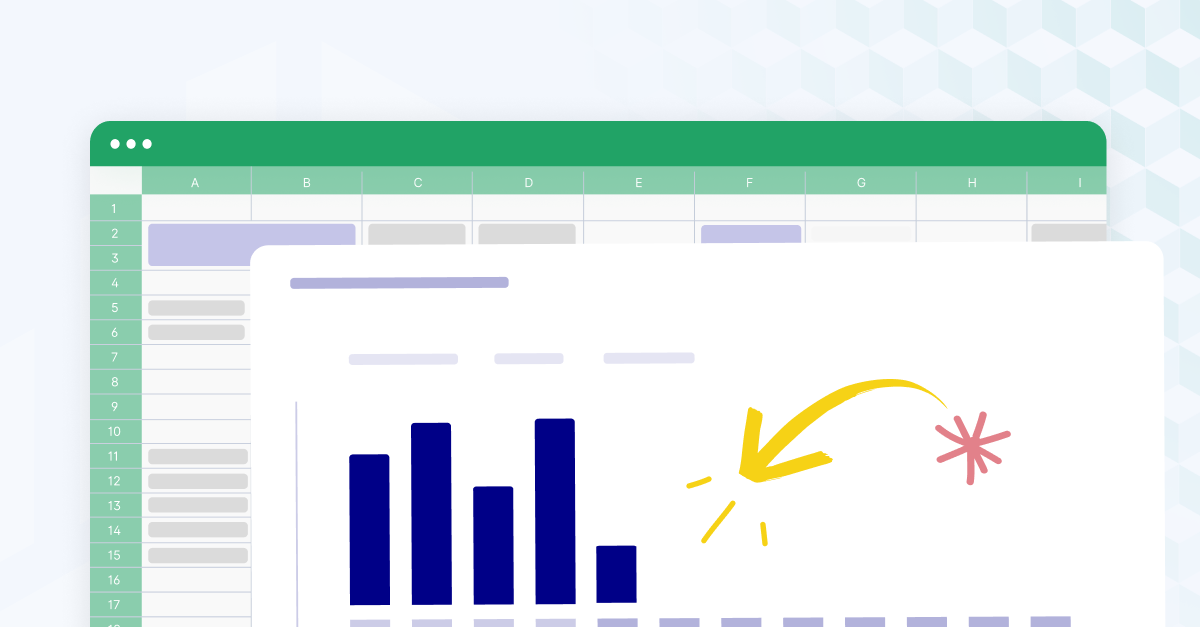Key takeaways on top-down and bottom-up budgeting
- Top-down budgeting is quicker, more centralized, and FP&A-driven–but can lack employee buy-in.
- Bottom-up budgeting leads to more employee buy-in and an accurate budget, but might lead to over-budgeting or lack of a focused directive.
- Neither approach is strictly better or worse than the other; they both have their own strengths and weaknesses.
- Most companies use both approaches and iterate until there's a cohesive story.
What is top-down budgeting?
Top-down budgeting is when senior management prescribes a budget for the entire organization. Each department then has to allocate that amount for their own needs. But they're restricted by the number that senior management gives them.
Advantages of top-down budgeting
There are a few big advantages to top-down budgeting:
- Time savings: With only senior management involved in the budgeting process, lower management can keep the business running without having to allocate time for the (often extensive) budgeting process.
- Highly strategic: Senior management has access to the entire company's finances. They can use that data to make highly strategic monetary decisions that departments without the big picture might not see.
- Unified direction: Since the budget comes from a unified source (typically top management), there’s a clear, unified plan across all levels of the organization, ensuring that all departments and teams are working towards the same goal.
- Guaranteed executive buy-in: Financial executives are the ones who agree on the budget. There's no need to worry about whether upper management will have issues with the budget.
- Easier to manage: Upper management controls the budget, making it easier to adjust without requiring approval from other departments
Disadvantages of top-down budgeting
In general, top-down budgeting is a central, strategic method. That said, there are plenty of disadvantages of top-down budgeting:
- Lack of on-ground knowledge: The employees doing the business's day-to-day tasks know what will make the biggest impact for them. Senior management might not always know or understand that.
- Communication mishaps: The above problem results from poor communication, which is sometimes unavoidable (especially during the busy budgeting season). Regardless, communication mistakes can lead to teams not getting the money they need to make strategic changes.
- Lack of employee and lower/middle-management buy-in: If employees aren't actively involved in the budgeting process, they might feel like their input isn't valuable; this can lead to lower engagement and frustration on the job, neither of which is the intent.
In general, top-down budgeting isn't perfect and has some serious pitfalls to watch out for.

What is bottom-up budgeting?
If top-down budgeting is prescriptive, bottom-up budgeting is descriptive. With a bottom-up approach, the lower management and employees create a budget and send it up the management chain for approval, where it finally gets to the office of the CFO.
Then, in an iterative process, the CFO suggests changes to the budget and sends it back down, and so on, until everybody reaches an agreement. In other words, the CFO creates a master budget with input from the entire company.
Advantages of bottom-up budgeting
Bottom-up budgeting has a few unique strengths:
- Employee enrollment in the budget: Since employees are so involved in the budgeting process, companies that use bottom-up budgeting see more employee buy-in into the end product.
- Empowers employee ownership and stewardship of the budget: Employees feeling more ownership of the end product means more conversations about how to use the funds in the budget best.
- More communication: Bottom-up budgeting is an iterative process involving employees and senior management; it requires more conversations between all parties.
- Still centralized: At the end of the day, the Office of the CFO still has the power of the purse to allow or deny items in the budget. So bottom-up budgeting allows companies to have a central strategy in mind while including employee knowledge.
- More accurate budgeting: Employees, being closest to the actual costs, provide more precise estimates, resulting in more accurate budgets.
Generally, bottom-up budgeting companies will be more satisfied with the end product overall.
Disadvantages of bottom-up budgeting
That said, there are a few things that might make bottom-up budgeting less than ideal for you:
- Higher spending, probably: When departments can ask for what they want, the Office of the CFO will likely end up with an asking total higher than what they're willing to give. After various compromises, the spending will probably be more than the Office of the CFO initially set out to spend.
- More time intensive: Increased communication and inputs mean employees and senior management will need to spend more time on the budgeting process as a whole.
- Potential mismatch between departmental vs. organizational objectives: The decentralized nature of bottom-up budgeting can lead to departments focusing on their own needs, potentially losing sight of broader organizational objectives.
- Can create a "spend it or lose it" mentality: If departments don't use all the budget they asked for, that can signal to upper management that they'll repeat that next year. This means departments might waste any excess funds in their budget just to hit their number.
How to choose between top-down vs. bottom-up budgeting
You might be wondering: which approach is the best for me? What will give me the best results?
And the answer is: It depends.
Top-down budgeting is ideal when running a tight ship and using your funds to serve a few strategic goals. Visionary companies with FP&A teams highly attuned to each department will do well with top-down budgeting.
Bottom-up budgeting is ideal for companies who want to give employees ownership of their budget and the department's direction. Companies with a culture of transparency, strong interdepartmental communication, and a finance team that keep track of the larger organizational goals will do well with bottom-up budgeting.

Top-down vs. bottom-up budgeting: Strategies across industries
These examples showcase the diversity of budgeting approaches across sectors, emphasizing the importance of selecting strategies that align with industry-specific dynamics.
Business budgeting with a top-down approach
Manufacturing, business services, and healthcare businesses lean toward top-down budgeting. Here’s how it works for them:
- Manufacturing: In the manufacturing sector, a top-down approach enables manufacturing companies to establish company-wide targets for production volumes and cost controls. Senior management can leverage a holistic view of organizational objectives, and direct the budgeting process.
- Business services: Within the business services sector, a top-down approach allows the organization to define comprehensive targets for service delivery and cost management. This enables management to take the lead in formulating budgetary directives, drawing from an overarching understanding of corporate goals.
- Healthcare: In the healthcare sector, a top-down strategy shapes overarching goals for patient care, operational efficiency, and cost management. Drawing from a comprehensive understanding of healthcare objectives, top executives in healthcare businesses take the lead in shaping the budget.
Business budgeting with a bottom-up approach
Here’s how businesses that operate in real estate, financial services, and hospitality use bottom-up budgeting:
- Real estate: In the real estate sector, a bottom-up approach involves collaborative input from property managers, leasing teams, and maintenance staff. For real estate businesses, this ensures detailed consideration of property-specific needs, tailoring budgets to each property's unique characteristics for effective management and development projects.
- Financial services: Within the financial service industry, adopting a bottom-up approach entails collaboration among diverse teams. This collaborative input ensures detailed consideration of risk mitigation, regulatory compliance, and client service strategies.
- Hospitality and event management: The hospitality industry often adopts a bottom-up approach for event-specific budgets. Teams collaborate to estimate costs related to venue bookings, catering, and entertainment, ensuring that each event is financially optimized.
The power of a hybrid budgeting approach
Why choose between top-down and bottom-up budgeting when you can harness the strengths of both through a hybrid approach?
Combining elements of both approaches can mitigate concerns. For example, setting top-down targets and allowing bottom-up adjustments within those constraints can strike a balance between efficiency and detailed insights.
- Mitigating over-budgeting concerns: By integrating a hybrid model, organizations can establish top-down targets and leverage bottom-up adjustments within those constraints, striking a balance that mitigates the risk of over-budgeting.
- Enhancing employee engagement and ownership: A hybrid approach empowers employees by involving them in the budgeting process, fostering a sense of ownership and accountability. This increased engagement often translates into more informed and committed spending.
- Achieving adaptability in dynamic environments: The flexibility within a hybrid approach allows organizations to adjust to unforeseen circumstances. Top-down guidance ensures alignment with strategic goals, while the iterative nature of bottom-up adjustments accommodates real-time adaptability.
- Meeting diverse stakeholder expectations: A hybrid model allows businesses to consider diverse stakeholder expectations. By incorporating input from multiple levels, the budgeting process becomes more inclusive, addressing a broader range of stakeholder needs and priorities.
Top-down vs. bottom-up budgeting: Choose the best strategy for your business
Now that you understand the difference between top-down and bottom-up budgeting, you can make a more informed decision about which approach fits your organization.
Top-down budgeting stands out for its centralized, mission-focused decision-making, which ensures quick and aligned financial actions. Meanwhile, bottom-up budgeting, driven by departmental input, not only enhances accuracy but also fosters a stronger sense of ownership among employees, aligning their efforts with company goals.
Each method has its strengths. The key is selecting the one that fits your company’s unique needs and goals, ensuring your financial strategy is both effective and aligned with your broader objectives.
If you're looking to streamline your budgeting process, Cube offers a comprehensive solution that automates manual tasks, builds rolling forecasts, and integrates seamlessly with tools like Excel and Google Sheets.
Ready to streamline your budgeting process? Cube can help you automate and optimize your strategy—book a personalized demo today.



.png)









.png)
.png)
![Top-down vs. bottom-up budgeting: Which should you use? [2025]](https://www.cubesoftware.com/hubfs/top-down-bottom-up-budgeting-1.png)



![Top-down vs bottom-up planning [2025]](https://www.cubesoftware.com/hubfs/top-down%20vs%20bottom-up%20planning%20new.png)

.png)